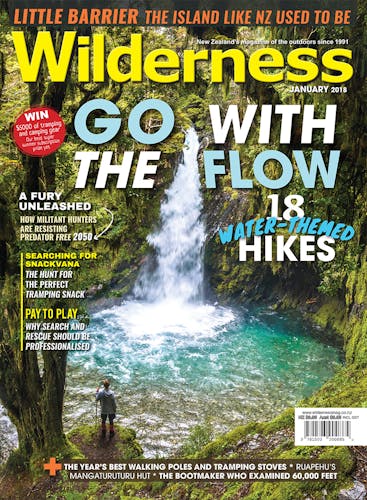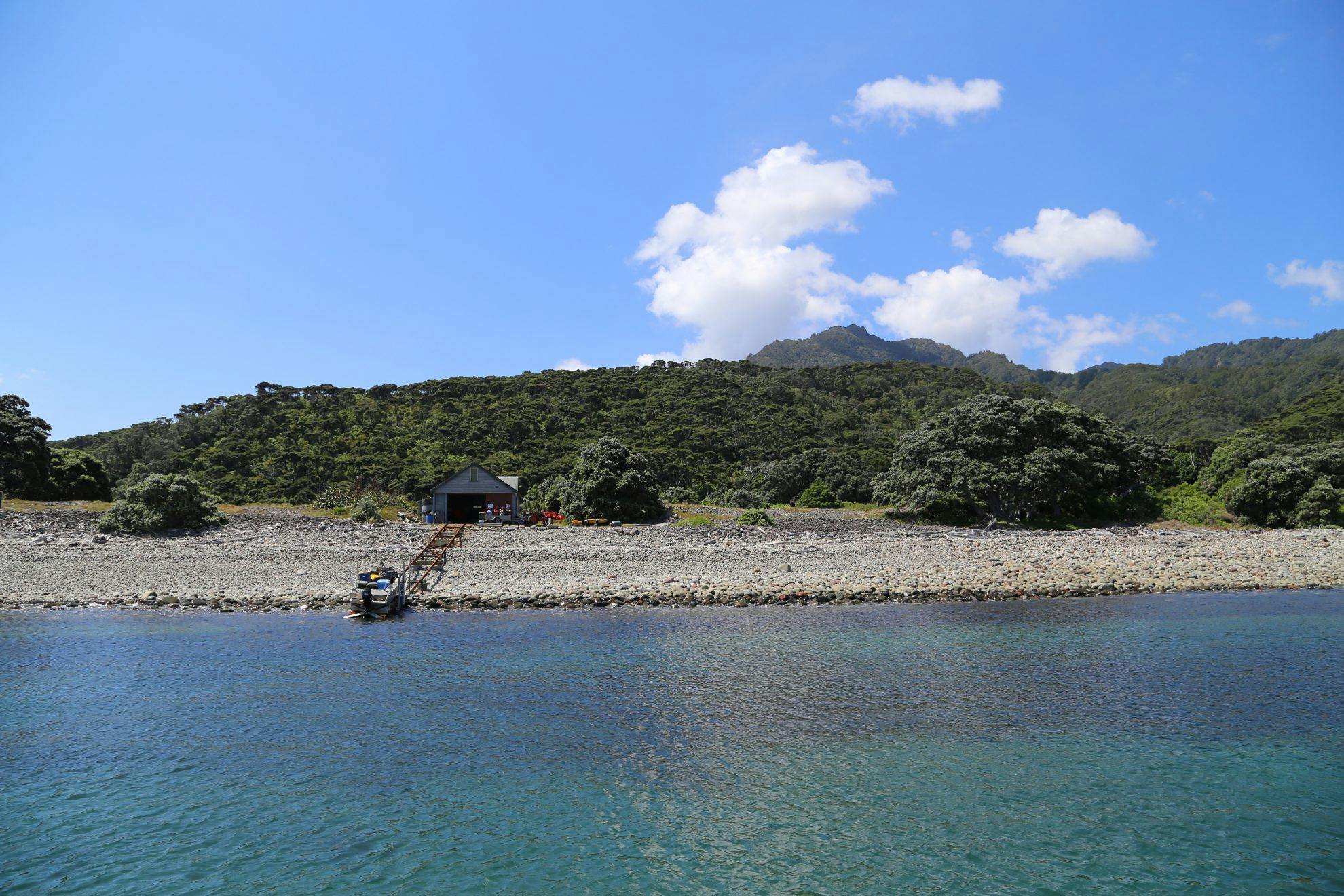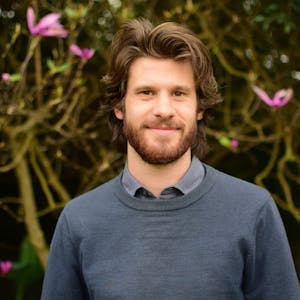Like a Noah’s Ark of New Zealand wildlife, Hauturu/Little Barrier Island has one of the most intact and diverse ecosystems anywhere in the country. George Driver visited New Zealand’s first nature reserve to see what Aotearoa was once like.
It started before I stepped off the boat. Skimming the deep blue waves, a New Zealand storm petrel escorted the DOC vessel Hauturu on our journey to Hauturu/Little Barrier Island. Thought extinct for more than 100 years, the seabird was rediscovered in 2003 and its only known nest site is on Little Barrier. It was the first of many encounters with Aotearoa’s rarified flora and fauna that I would experience over the next 24 hours.
Rising 722m out of the Hauraki Gulf, with access tightly restricted, Little Barrier has a mystique that few locations possess. The extinct volcano pierces the skyline of the Pacific, and beneath its rich green canopy, it harbours iconic species such as kiwi, tuatara and kakapo.
“It’s as close as you can get to what New Zealand was like before people arrived,” says Little Barrier ranger Richard Walle.
After getting ashore, this became immediately obvious. A saddleback/tieke flittered through coprosma and flax growing from the boulder-lined coast, cackling its distinctive staccato call, now all but silenced on the mainland. A small weeding team, which had been working on the island for about three months, helped unload the boat – whose cargo included live locusts for the baby tuatara. One of the workers rifled off each call we could hear – shining cuckoo, kaka, bellbird.
But before I could explore, I had to head to the island’s quarantine shed for a final inspection. Visitors must get a permit to visit the island and undergo a strict quarantine inspection before landing. Visitor numbers are restricted to 600 a year, but most years only about 200 people get a permit. The rigmarole of quarantine started the night before, when I washed all of my clothing, inspected every element of my footwear for soil and seeds and turned out every pocket to look for unwanted passengers. This inspection was repeated in a sterile room resembling an operating theatre at the Warkworth DOC office. Under blinding fluorescent lights, I put my possessions on the stainless steel tables to be scrutinised. Again, every pocket was turned out, every patch of Velcro inspected. Walle even pulled out a set of tweezers to pick stubborn seeds from the sole of his boot.
After quarantine, I was free to roam. Chaperoned by DOC communications advisor Nick Hirst, we looked around agog, listening to the cacophony of calls and watching the stream of birds flying overhead. I poked my head into a bush and saw a saddleback scratching through the undergrowth, like a sparrow. Walle says each species fills a niche on the island, replacing the roles which have now been taken up by introduced species on the mainland.
“Hauturu isn’t about active management,” Walle says. “It’s about supporting a strong, natural ecosystem. When you’ve got that, even introduced species can’t push in, because every niche is taken by native species.”
Walle has lived on the island with his wife Leigh Joyce and two children, Liam (12) and Mahina (14) for the past six years. But his adventure started well before Hauturu. Growing up in Germany, close to the border with the Netherlands, he became a carpenter after high school and joined the Journeyman, an 800 year old organisation for travelling craftsmen.
“When you join, you have 24 hours to get at least 50km away from your hometown and you aren’t allowed to return for the next three years,” Walle says. “I liked the history of the guild, and the adventure of experiencing new things. I learned a lot about life.”
Walle worked his way through Europe, England and Scotland and on to Australia. He came to New Zealand in 1989 and, struck by the friendly culture, stunning scenery and unique flora and fauna, became determined to stay.
He started his career with DOC restoring the Donovan’s Store in Okarito – the oldest building on the West Coast. He also met Leigh at Okarito – she was camped on the beach, studying kiwi in the area.
The couple soon started their island odyssey, working on Stewart Island. Richard worked for DOC repairing huts and tracks, including helping build the Rakiura Great Walk. Leigh studied kakapo as part of a PhD on the birds.
They later headed to Bougainville in Papua New Guinea, working for Volunteer Service Abroad, helping communities recover from the 10-year long civil war between 1988-1998. When they returned to New Zealand, they became resident rangers on the Maud Island Scientific Reserve in Marlborough Sounds, where they lived for six years. Their children started life on Maud, before the family moved to Little Barrier. They are both homeschooled, with the freedom to follow their interests and learn at their own pace. With a steady stream of scientists visiting the island, Walle says they have no shortage of teachers.
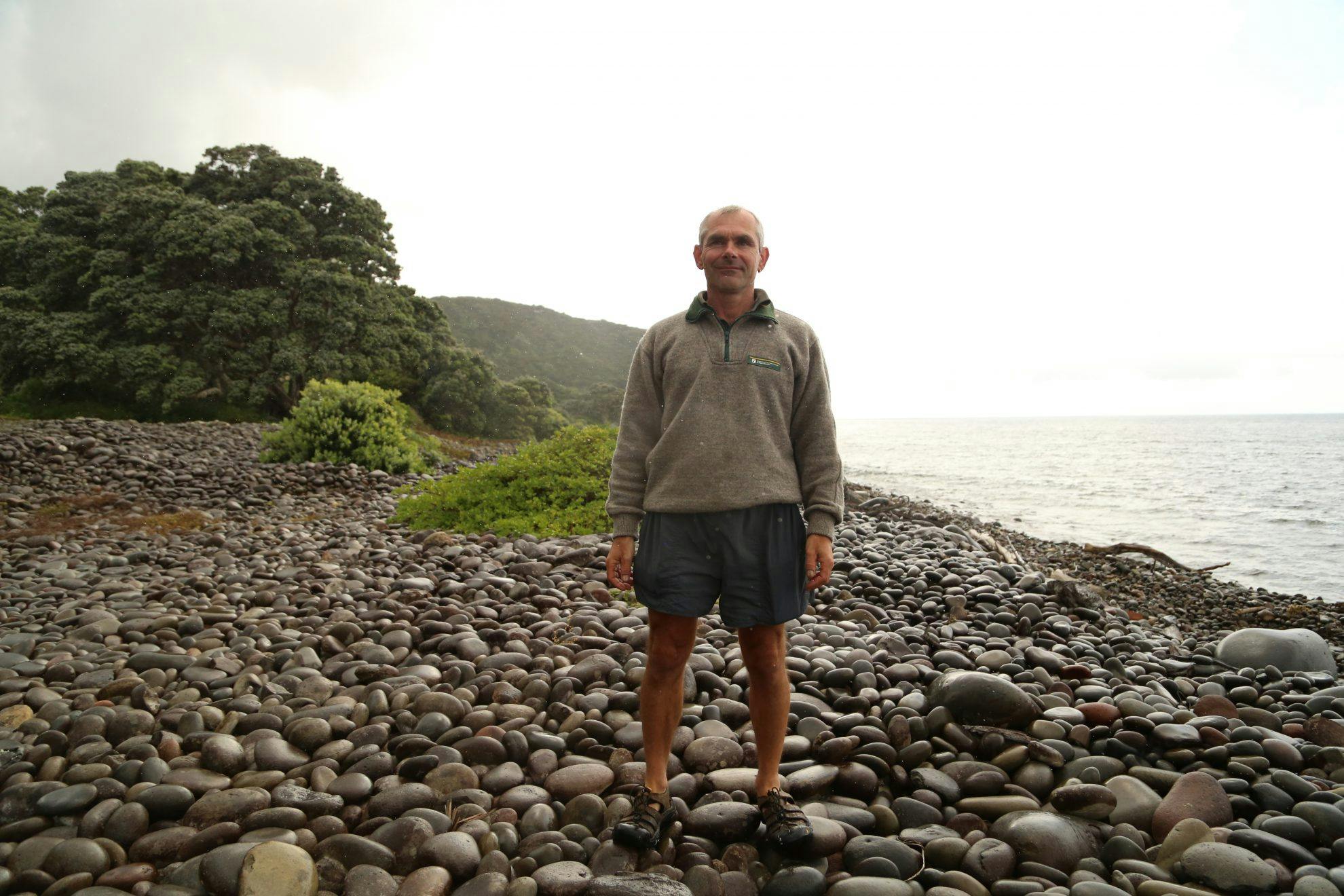
Richard Walle has lived and worked on the island with his family for six years.
Photo: George Driver
“A lot of the scientists take them under their wing. I’ll go for a walk with Liam and he’ll know the Latin, English and Maori name of every plant we walk past. I think it’s an incredible education.”
Walle says they have the choice to go to school on the mainland, but they haven’t been tempted yet.
“They know what it’s like in the city and when they think about what they have here they aren’t interested in leaving.”
At Little Barrier, Walle is responsible for managing visitors and workers, patrolling the island to prevent people from landing, and monitoring the trapping network.
“It’s pretty fantastic. But when I get back to the mainland, it’s quite a culture shock. You realise just how highly modified the environment is.”
Exploring one of the tracks, I was startled by the whooping wings of a New Zealand pigeon/kereru fleeing the undergrowth. On the mainland, these birds are reconciled to the treetops due to predators, but here their natural behaviour is on display and, along with kokako, they regularly graze on the lawn outside the ranger’s headquarters.
“From a scientific perspective, it’s a diamond of a place,” says Auckland University of Technology associate professor Dr David Towns. “Little Barrier is probably the most diverse ecosystem in the world where predators have been removed, so we can learn a lot about how an ecosystem changes and adapts.”
Towns worked as a science advisor for DOC on the case to eradicate kiore rats from the island in 2004. Since then, wildlife has continued to rebound. But he says the ecosystem will take hundreds of years to fully regenerate.
“Some of the species there are very long-lived and it will take hundreds of years for them to come back to good numbers. Take tuatara – numbers on the island went down to eight animals in the 1990s. Over 100 eggs have now been hatched and released there, but the average density on other predator-free islands is up to 2500 per hectare, so there’s a long way to go.”
The 3000ha island has over 400 native plant species and is New Zealand’s largest forest area undisturbed by browsing mammals. The steep slopes create a range of environments. Pohutukawa line the coastline, kanuka and puriri dominate the lower slopes, with kauri forest higher up. Northern rata, beech and tawaroa are found at mid-altitudes, and the island is crowned with a cloud forest with southern rata, totara and nikau, all covered in moss.
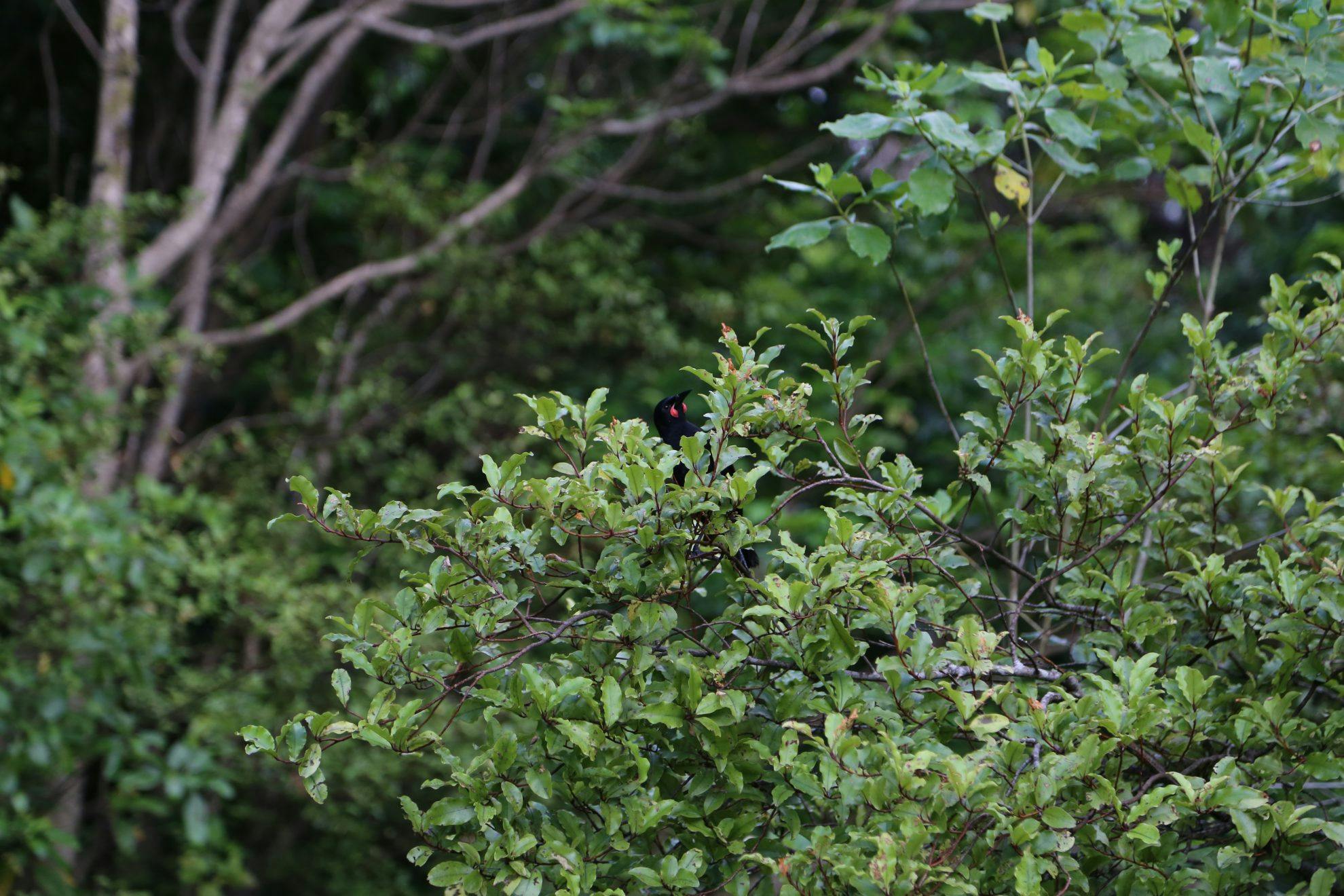
Saddleback – virtually disappeared from the mainland – are amongst the most populous birds on the island. Photo: George Driver
Some species also exhibit unusual characteristics. One of the most striking examples is the nikau palm, which has gargantuan fronds – at least four metres – and reach a height I’d never seen before.
On a two hour walk up a ridgeline to near the summit, we were followed by curious saddlebacks and visited by fantail, kaka and kakariki. I was struck by the realisation that everything I could hear and see was native – there’s an almost spiritual dimension to experiencing an ecosystem in its natural state. When you talk to people who have visited Little Barrier, you see their eyes glaze over as they slip back to their experience – something beyond articulation. I felt I finally understood.
But that realisation also comes with a sense of loss, of what is now gone from the mainland. None feel this more than Ngati Manuhiri, whose people were evicted from the island in 1896. According to a DOC heritage assessment, the Crown first entered negotiations to purchase the land from local iwi to create a bird sanctuary in 1881, but there was confusion about exactly which iwi had the right to sell it. After negotiations with the Crown fell through, one of the Maori owners, Ngati Manuhiri chief Tenetahi, attempted to sell rights to fell the kauri on the island to a logging firm. The Government issued an injunction to prevent the sale and in 1891 the other Maori owners signed a purchase agreement with the Crown. But Tenetahi never agreed to sell. When Tenetahi continued felling trees, the Government passed the Little Barrier Purchase Act in 1894, forcing Tenetahi to sell his share. Little Barrier became New Zealand’s first Nature Reserve a year later, set aside to protect native birds. The following year, Tenetahi and his wife Te Kiri were handcuffed and evicted from the island. According to Ngati Manuhiri, Te Kiri’s daughter swam back to Hauturu three times, attempting to return to her home.
“After the third time, the Crown said ‘if you come back we will put you and all of your family in jail’,” says Te Ao Rosieur, a member of Ngati Manuhiri. “They gave her a stuffed huia from the island as a gift and said ‘don’t come back’.”
Roseiur says that huia is still a treasured possession of the iwi.
Ngati Manuhiri settled with the Crown in 2012 and ownership of the island returned to the iwi. But Ngati Manuhiri gifted the island back to the Crown 24 hours later and it now has a co-governance role with DOC. The iwi has also retained a hectare of land to build a whare, close to the DOC headquarters. Before anyone heads to the island for the first time they must meet members of the iwi. At Ngati Manuhiri’s head office near Leigh, Rosieur said the island was still their spiritual home.
“It is where it all began for us,” Rosieur said. “We’ve all grown up with the stories about Te Kiri and Tenetahi. When I first went back, to actually put my foot on the first boulder on the shore, it was like feeling the pulse of a heartbeat. It felt like ‘I’m back’.”
Rosieur said she had come to terms with being evicted from Hauturu.
“You get to the point where you’ve got to build a bridge and make the best with what you have.”
Despite its controversial past, the creation of the reserve showed a great deal of foresight, protecting native wildlife at a time when environmental destruction was prolific. Concerns were already being raised about the loss of native birdlife in the 1880s. In 1886, Austrian naturalist and notorious bird collector Andreas Reischek presented a paper to the Auckland Institute and Museum about the island’s abundant birdlife, and helped convince leaders at the time of the need to protect it. (Reischek made his own contribution to the decline of some of the island’s species – he later returned to Vienna with 3000 specimens, still one of the most intact collections of NZ birds). He said the island would make a “favourable resort” for kakapo, saddleback and kokako.
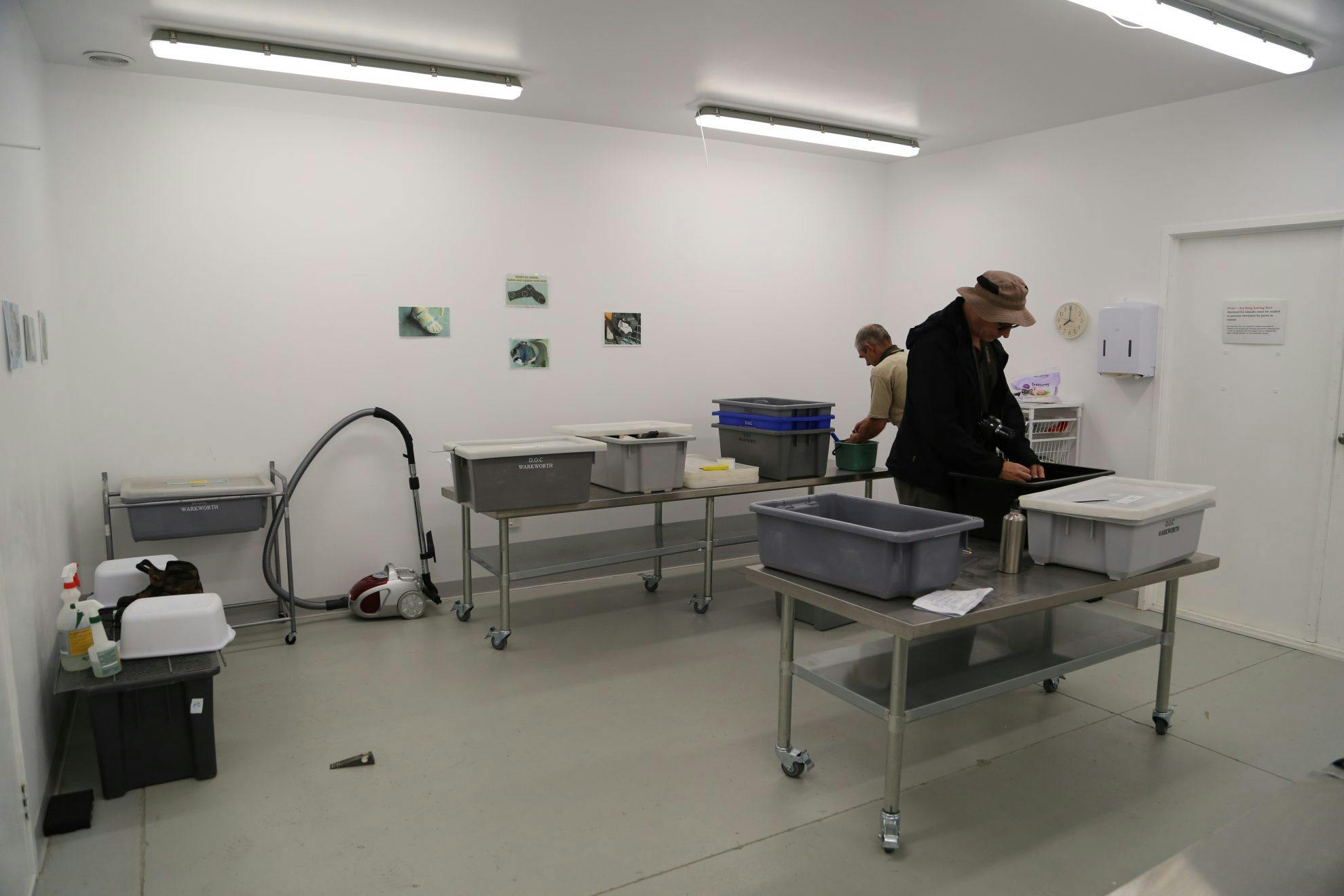
Before visiting Little Barrier, all gear must be scrupulously cleaned. Photo: George Driver
“After many years of studying the habitats of New Zealand birds, I could not recommend a more favourable place,” he told the institute. “It would be of great benefit to science and agriculture to have such a means of preventing the extinction of these remarkable birds…I will be most happy to procure live specimens of both sexes of kiwi and kakapo if the committee will provide me with cages and arrange for the transport.”
He said the birds could be fed mashed potatoes and “common biscuits soaked in water, with sugar, and a few meal-worms or ant eggs” to sustain them while they were transported from the West Coast.
After emerging from the depths of the forest, I returned to the DOC homestead and watched the sunset over the mainland, spotting the distinctive zig-zagging flight of native long tailed bats (Little Barrier has both the long tailed and short tailed bats – New Zealand’s only native mammals) and listened as morepork/ruru started to call. After dark, kiwi joined the chorus – first the piercing sound of the male, followed by the throaty return call of the female. Heading into the night, it became clear life doesn’t stop after dark. There were hundreds of Cook’s petrels screeching overhead, calling as they crashed through the forest to their nests. Walle said the island is the world’s largest breeding ground of Cook’s petrel, with about 30,000 pairs, and breeding rates have skyrocketed since rats were eradicated. Another seabird call we could hear had a not-so-natural source. Researches have set up speakers which play the storm petrel’s call in an attempt to establish a new colony which is more accessible and easier to study. Scientists also direct petrels to the new nesting site using spotlights – if you shine a spotlight at a petrel flying above it can be directed by the beam of light, like they are caught in a tractor beam. Later, we came across a number of tuatara, crashing through the undergrowth, and found weta clinging to the underside of leaves.
After getting to bed at midnight, I awoke wearily to my alarm at 5am to hear the dawn chorus. Dragging myself out of bed, I heard the first haunting notes of the kokako and I hurried out the door. Singing in repetitive, deep and sonorous notes, it’s a haunting call – a baritone to the tenor tweets and whistles of the tui and bellbird. Later in the morning, a light drizzle fell on the island and the birdsong picked up again as I headed to the boat to leave. A small pod of bottlenose dolphins came to escort us off the island and common dolphins leaped above the waves on the way back to the mainland.
As the island receded into the distance, the details of its dramatic valleys blurred by the ocean haze, I thought how Little Barrier acts as a reminder of both what we had, and what we’ve lost. It encapsulates an ideal, and a challenge. Over 120 years ago, people had the foresight to protect the island’s flora and fauna (despite the draconian way that was executed). But since then the distance between the island’s abundance and the decline of species on the mainland has grown wider. Having experienced Hauturu, I think it’s time to close that gap.
Paradise saved
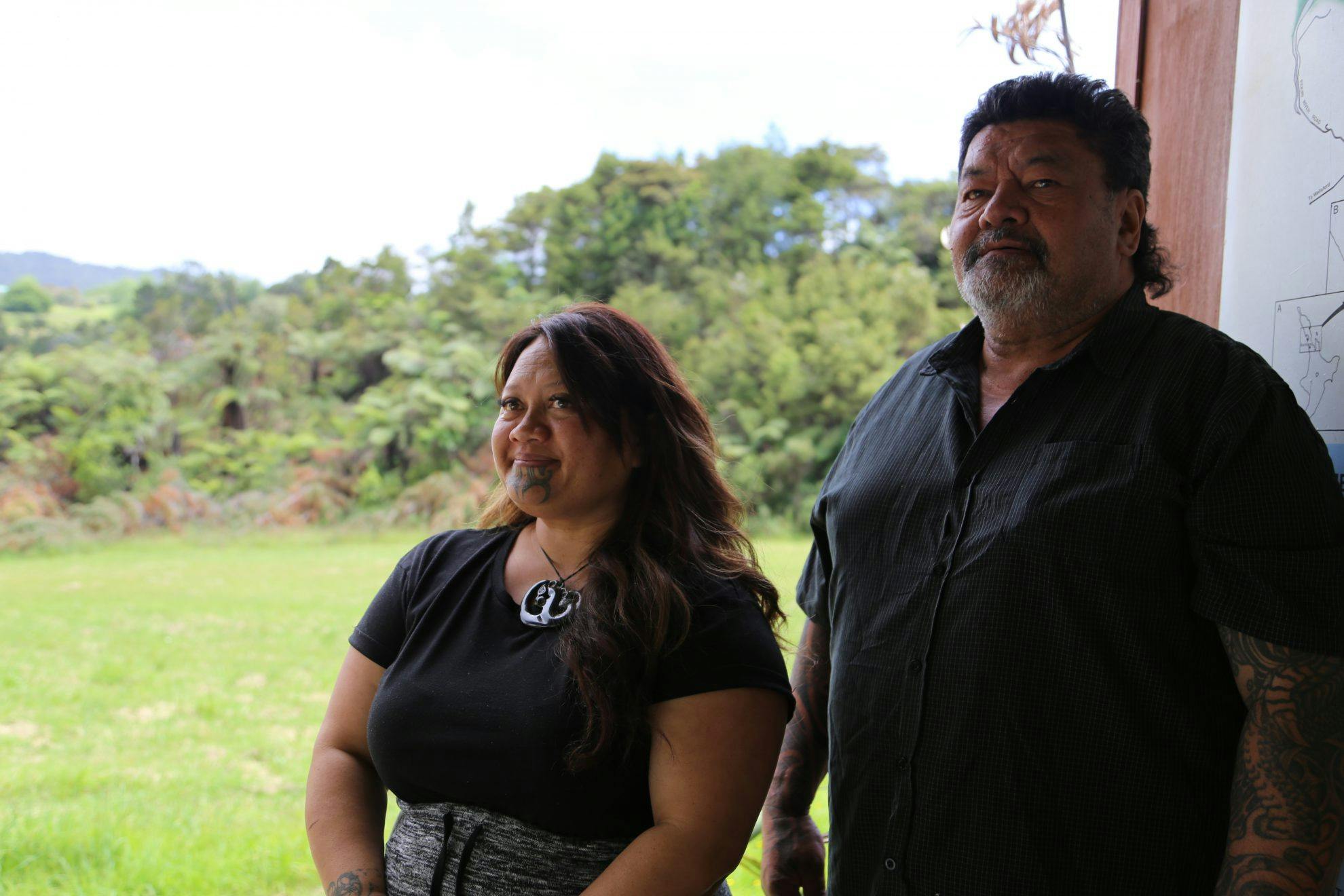
Te Ao Rosieur and Ringi Brown of Ngati Manuhiri say the iwi plans to build a whare on Hauturu to reaffirm their connection to the island. Photo: George Driver
Little Barrier didn’t escape the impacts of introduced species or human development. According to a DOC heritage report, between 1860 and 1890 about a third of the island’s forest was either logged or burnt. Cattle, sheep and pigs roamed widely and kiore (Pacific rats) and cats were also introduced. But the island was spared the blight of mustelids (stoats, weasels and ferrets) and it was still a comparative safe haven. It had the last remaining populations of stitchbird/hihi and giant weta – one of the largest species of insect in the world.
The island has a long history of being a refuge – North Island brown kiwi and kakapo were reintroduced in 1903, great spotted kiwi in 1915 and saddlebacks in 1925.
After years of trapping, cats were finally eradicated from the island in 1981. Kakapo were reintroduced the following year – 23 made the island home, which was then nearly half the birds’ entire population. North Island kokako were also reintroduced in 1981 and saddleback were again reintroduced in 1984, after earlier attempts failed.
Kiore were eradicated in 2004 and the island was finally predator free.
Weed control continues – mainly to eradicate the last remnants of climbing asparagus. Protecting the island continues on the mainland, as community groups work to prevent seeds blowing 22km across Jellicoe Channel to the island.
A not so short history
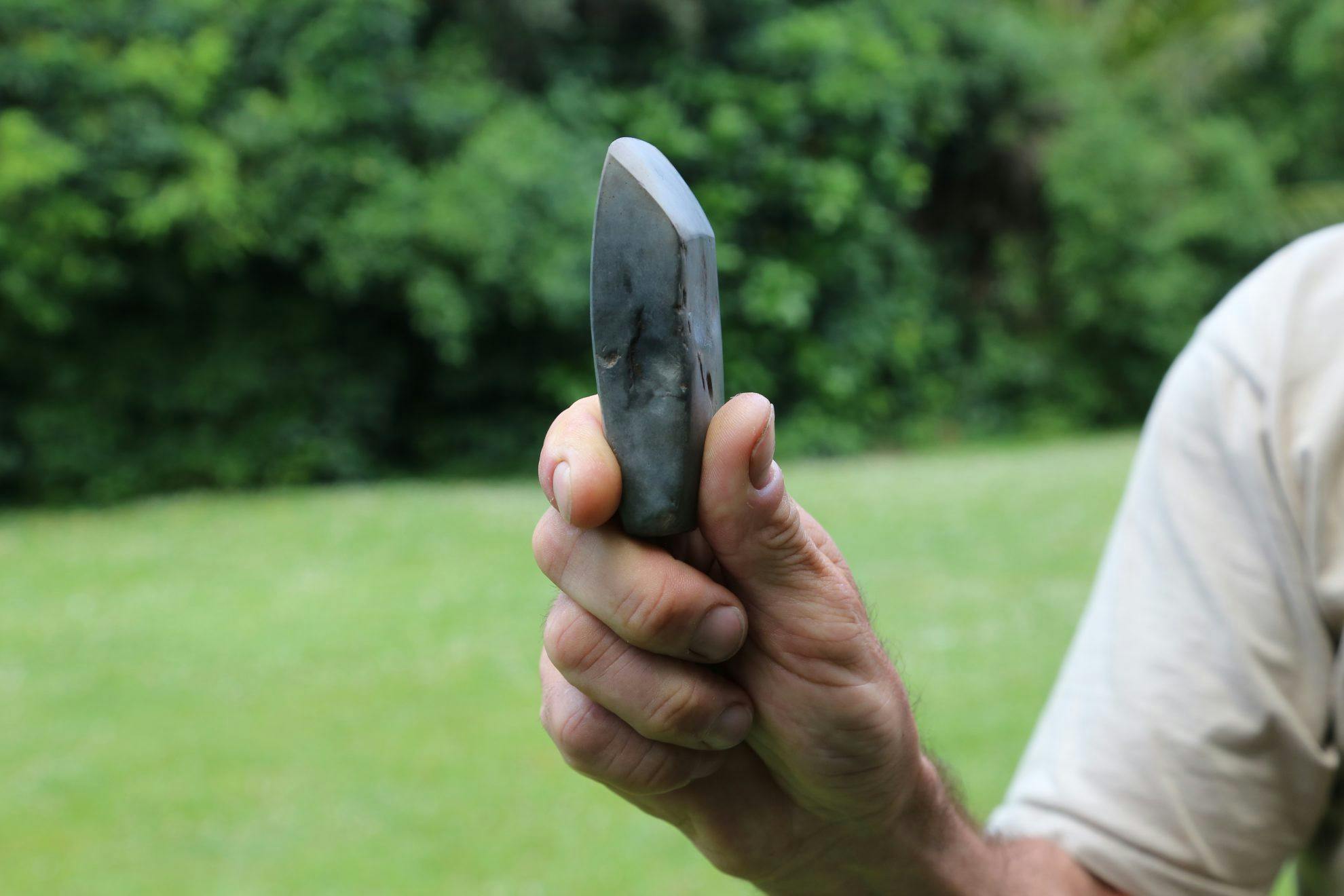
A sharpened adze found on Little Barrier Island. Photo: George Driver
Maori first settled the island about 800 years ago. There are still pa sites, old garden walls, midden sites, burial grounds, and even defensive trenches from former settlements. A number of relics have also been found, most recently a sharpened adze head (pictured), which was unearthed on a track in 2016. DOC protocol is that all taonga found on the island stays there.





